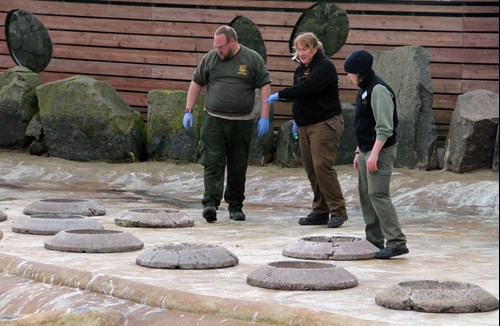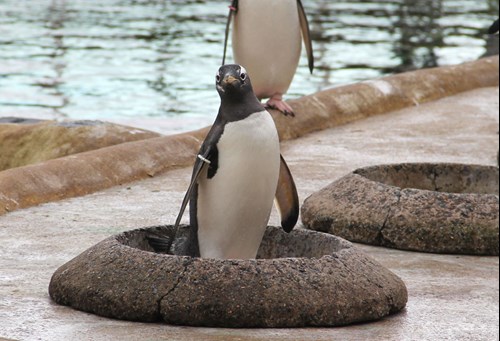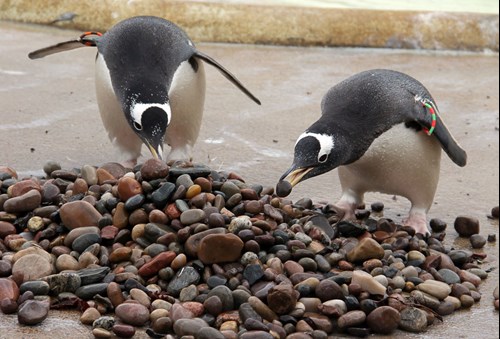P-p-pick up a pebble for penguin breeding season
01/03/2016 in Edinburgh Zoo
The female gentoo penguins at Penguins Rock at RZSS Edinburgh Zoo want only one thing this penguin breeding season, and that’s to be wooed with a nice, shiny pebble.

Keepers at RZSS Edinburgh Zoo placed the annual penguin nest rings and pebbles into Penguins Rock on 1 March to kick off the penguins’ annual breeding season. The pebbles are the gentoos’ version of engagement rings, which the males use to court a potential mate. As soon as the pebbles were placed in Penguins Rock, the black and white birds made a mad dash to pick out the perfect pebble in order to woo a future partner.
The keepers will place the pebbles in a large heart-shape to celebrate the start of breeding season and to make it that little bit more special for the gentoos.
 Dawn Nicol, Penguin Keeper at RZSS Edinburgh Zoo, said: “The start of penguin breeding season is the busiest time of the year for bird keepers, but it is also the most exciting. Every year when we place the pebbles and nest rings into Penguins Rock we love to see the penguins dash off to pick out perfect pebbles and present it to their mate. It is also always nice to see how well the pairs look after each other and their eggs, as both parents will share the responsibility of incubating and raising the chicks.
Dawn Nicol, Penguin Keeper at RZSS Edinburgh Zoo, said: “The start of penguin breeding season is the busiest time of the year for bird keepers, but it is also the most exciting. Every year when we place the pebbles and nest rings into Penguins Rock we love to see the penguins dash off to pick out perfect pebbles and present it to their mate. It is also always nice to see how well the pairs look after each other and their eggs, as both parents will share the responsibility of incubating and raising the chicks.
“Once the gentoos have found a mate and filled their nests with the best looking pebbles, the first eggs should start to appear in April, with the first hatchings in May after a 33-35 day incubation period.”
The penguins are given a large selection of pebbles to choose from, but the gentoos will often steal the prettier looking pebbles from their neighbours, which results in a fair bit of Penguins Rock drama. The female gentoos will place their shiny new pebbles in the nest rings which they will then lay their eggs into.

Penguins will often choose to court the same mate for breeding season; however, contrary to popular belief, not all penguins mate for life as some choose to go their separate ways. Same sex penguin partnerships are not uncommon and they tend to make great parents, as keepers will redistribute eggs from nests which have too many and give them to same sex partnered penguins to rear.
Meanwhile, on Monday 29 February, the rockhopper penguins were moved up to their own enclosure for breeding season, which suits their natural breeding behaviour perfectly. The keepers are hopeful for rockhopper chicks this year as many of the younger birds have reached sexual maturity. Rockhoppers are currently listed as Vulnerable by the IUCN, but due to rapidly declining populations they may be listed as Endangered in the near future, making the hatching of chicks all the more important to ensure a safety-net population for this increasingly threatened species.
The RZSS Edinburgh Zoo penguin cams have been moved over to the gentoo nesting site to allow fans to keep up with all the nesting activity. Viewers may see the penguins carrying stones and placing them in the centre of the nest, which creates a useful protective barrier for the eggs and future chicks. As an extra protection measure, some birds may be seen lying down and kicking out stones with their feet to create a crevice in the middle of the nest. You can watch all the gentoo nesting activity here: http://www.edinburghzoo.org.uk/webcams/penguin-cam/
Gentoo penguins are the most northerly of the Antarctic penguins, found normally on the rocky islands of the sub-Antarctic Ocean. They are the third largest species of penguin, after king and emperor penguins. Gentoos can be distinguished by a white patch around and behind the eye and a bright orange-red bill. Gentoos are listed as Near Threatened on the IUCN Red List.
…ends…
Featured Articles

An update from the Budongo Forest
19/04/2024 in Conservation

Edinburgh Zoo named best zoo in Scotland
15/04/2024 in Edinburgh Zoo
Latest News
-
News

07/03/2024
Edinburgh children paint pretty pebbles for penguins
Edinburgh Zoo’s gentoo penguins have been given painted pebbles to celebrate the start of penguin breeding season.
-
Blog

20/01/2024
Penguin Awareness Day 2024
Edinburgh Zoo is home to the largest outdoor penguin pool in Europe, with three different species and over 100 individuals. This penguin awareness day get to know some of the famous faces in the colony who you can also watch live on our penguin cam.
-
Blog

24/10/2023
Caring for penguins at Edinburgh Zoo and beyond
Through their expertise and research, our vet team provide the highest standard of care for our animals and make important contributions to understanding how we can better protect wildlife. Dr. Stephanie Mota shares more about their recent research on a fungal disease which affects penguins.
-
News

21/08/2023
Sir Nils Olav promoted at Edinburgh Zoo
His Majesty the King’s Guard Band and Drill Team of Norway, who are performing at The Royal Edinburgh Military Tattoo this year, visited the Royal Zoological Society of Scotland’s (RZSS) Edinburgh Zoo to promote and bestow a unique honour upon the resident king penguin, Sir Nils Olav.

























Follow EZ